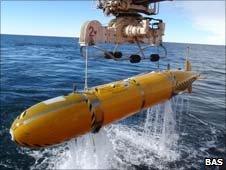Ridge clue to Antarctic ice loss
- Published

Pine Island Glacier is one of the largest in Antarctica
The discovery of an underwater ridge in West Antarctica could help explain why there has been an acceleration in the ice flowing from a glacier in the area.
Researchers suggest that the base of Pine Island Glacier once sat on the ridge, but recently became detached from the feature.
The team made the discovery during surveys that used a unmanned submarine to examine waters under the glacier.
The findings have been published in the journal Nature Geoscience.
"We found something very unexpected," said co-author Pierre Dutrieux, from the British Antarctic Survey (BAS), referring to the 400m-high ridge.
"Acoustic instruments on the submarine told us that there was a ridge at the bottom of the ocean, sitting transverse to the flow of ice."
Dr Dutrieux said that there was also evidence that the base of the glacier was once attached to the ridge.
"Some decades ago, the glacier was sitting on this ridge and the friction of the ridge was restraining the flow of the glacier," he explained.
"When the glacier became detached from the ridge, the ice flow was able to accelerate significantly."
Dr Dutrieux said that the glacier was located in an area where there was intense melting of land ice, which was flowing into the ocean and contributing to sea level rise.
Researchers estimate that the accelerating flow of glaciers in West Antarctica is contributing about 10% of the observed rise in the mean global sea level.
In 2009, a study of satellite measurements of Pine Island Glacier, which is one of the largest in Antarctica, revealed the surface of the ice was falling at a rate of up to 16m a year.
It added that the glacier was thinning four times faster than it was a decade earlier.
Ice dynamics
Dr Dutrieux said that the discovery of the ridge was an important piece in the jig-saw of factors that could be changing the ice dynamics in the region.
"We have not had a clear understanding of what is driving this melting because the atmospheric forcing - the temperature at the surface - is not warm enough to cause such a melting," he added.

The AUV has the capability to dive to depths of 1,600m below the surface
"So the hypothesis was that it was coming from the ocean, which was melting the ice shelf from below."
To gather the data, the team launched an Autonomous Underwater Vehicle (AUV) on six survey missions beneath the floating tongue of Pine Island Glacier.
The submersible was designed and built by a team from the National Oceanography Centre in Southampton, and funded by the UK's Natural Environment Research Council (Nerc).
The seven-metre long vessel, with a range of 400km, carried a multibeam sonar system that allowed it to build up a 3D map of the ocean bed below and ice above.
It also was fitted with devices that measured salinity, temperature and oxygen concentrations in the sea water.
This allowed the researchers to gain a better understanding of the flow of water within the ice cavity and the rate of melting.
"We now know that there is relatively warm water beneath this floating ice," observed Dr Dutrieux, "so this warm water could have been able to melt the base of the ice shelf.
"Another process leading to the ice becoming detached from the ridge could have been a change in the water properties that was grinding the shelf from beneath."
He said the presence of the ridge would change the basis of future work on ice dynamics in the area.
"Topography is the main thing that constrains ice flow so, basically, it is going to fundamentally change the way people think about this glacier and the way we understand how it behaves."